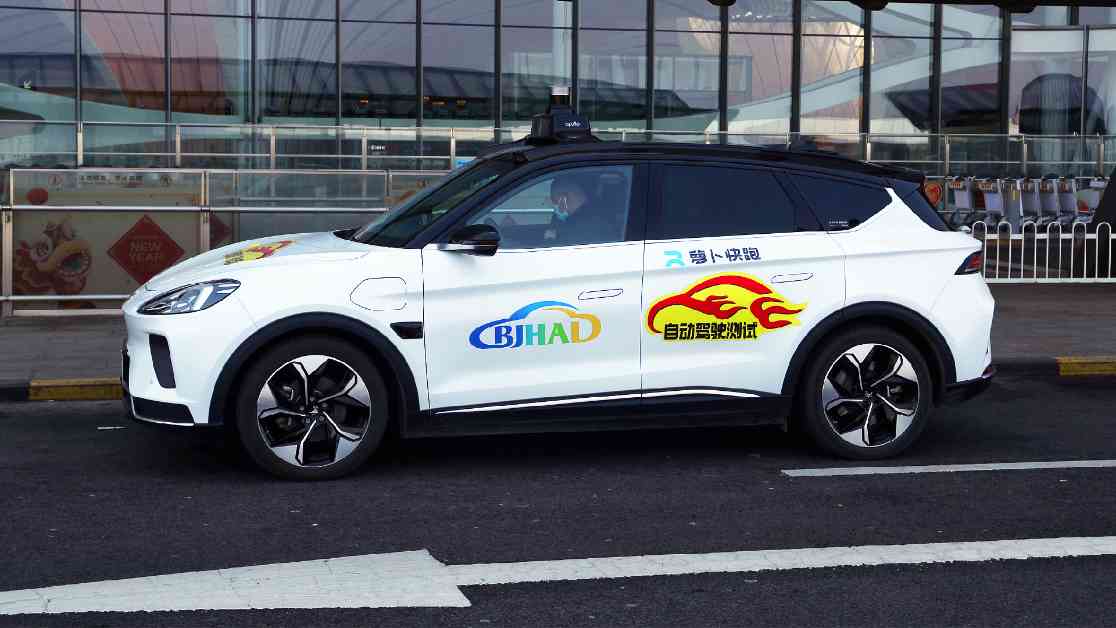China is making significant strides in the field of autonomous driving technology, with a notable example being the operation of robotaxis in Beijing E-Town. These cutting-edge robotaxis offer passengers a seamless and futuristic ride experience, with no human driver behind the wheel. This development is emblematic of the rapid advancement of autonomous driving technology in China, driven by a combination of technological innovation, supportive regulations, and enthusiastic investment.
Robotaxi Revolution in Beijing E-Town
In Beijing E-Town, a national-level economic-technological development area in the Chinese capital, passengers can now easily hail a ride in a state-of-the-art robotaxi. With just a few taps on a mobile app, passengers can embark on a journey from Beijing E-Town to Beijing Daxing International Airport in a fully autonomous vehicle. The absence of a human driver in the front seat may initially evoke feelings of unease for some passengers. However, as Zhang Ning, vice president of Chinese autonomous driving startup Pony.ai, points out, passengers quickly acclimate to the driverless experience and feel at ease within minutes of the ride.
The robotaxis deployed in Beijing E-Town are part of Pony.ai’s ambitious plan to expand its autonomous vehicle fleet in the city. Currently, nearly 100 robotaxis operate within a designated autonomous driving zone covering 160 square kilometers. Pony.ai aims to scale up this fleet to ten times its current size by 2025 or 2026, signaling the company’s confidence in the commercial viability of autonomous driving technology. Zhang emphasizes that reaching a critical mass of robotaxis in a city is key to achieving operational profitability, with Pony.ai targeting a fleet size of over 1,000 vehicles in a single city.
Expanding Horizons: From Robotaxis to Robotrucks
Pony.ai’s innovation extends beyond passenger transport to the realm of cargo transport with the introduction of autonomous robotrucks. The company currently operates around 200 fuel-driven robotrucks nationwide and is poised to introduce electric models to further scale up autonomous driving in the field of cargo transport. By integrating autonomous driving technology into the manufacturing process of new-generation vehicles in collaboration with Japanese carmaker Toyota, Pony.ai is enhancing production efficiency and driving technological progress in the industry.
The autonomous vehicles developed by Pony.ai are classified under L4 autonomy, signifying their ability to operate in most conditions without human intervention. This level of autonomy underscores the advanced and intelligent nature of the technology, positioning China at the forefront of autonomous driving development globally. The country’s proactive approach to fostering innovation in autonomous driving is evident in its early pilot programs and subsequent approval of commercial autonomous driving services.
Government Support and Technological Innovation
The rapid advancement of autonomous driving technology in China is underpinned by robust government support, technological progress, and investor interest. The country’s strategic focus on promoting artificial intelligence as a key industry aligns with the development of autonomous driving as a flagship application of AI. China’s proactive stance in issuing licenses for autonomous driving tests and supporting industry pilots has created a conducive environment for startups like Pony.ai to flourish.
Technological progress plays a pivotal role in enhancing the safety, efficiency, and comfort of autonomous vehicles. Pony.ai’s extensive testing of fully driverless vehicles has accumulated invaluable data surpassing what an individual driver could amass in a lifetime. The superior safety standards of autonomous driving technology compared to manned driving positions it as a transformative solution for mitigating human error-related traffic accidents in China.
Investor confidence in the autonomous driving industry is reflected in Pony.ai’s substantial financing and valuation, signaling a growing interest in the sector. The convergence of government support, technological innovation, and investor backing propels the industry forward, positioning China as a global leader in autonomous driving technology.
Global Expansion and Future Prospects
As China continues to drive innovation in autonomous driving, the industry’s global expansion is gaining momentum. Pony.ai’s foray into international markets such as the Republic of Korea, Luxembourg, and Saudi Arabia underscores the company’s commitment to showcasing Chinese technological prowess on a global stage. With a keen eye on profitability and market competitiveness, Pony.ai is poised to navigate the complexities of regulatory frameworks and technological advancements to sustain its growth trajectory.
Looking ahead, challenges persist in enhancing technology, refining regulations, and expanding operational landscapes for autonomous driving. The industry’s evolution hinges on collaborative efforts between government, industry players, and stakeholders to foster a conducive environment for innovation and growth. By leveraging government support, technological innovation, and investor confidence, China is poised to shape the future of autonomous driving and solidify its position as a trailblazer in the global autonomous vehicle market.
In conclusion, China’s rapid advancement in autonomous driving technology epitomizes the country’s commitment to fostering innovation and driving technological progress in high-tech industries. With a strategic focus on promoting artificial intelligence applications such as autonomous driving, China is not only leading the way in technological innovation but also setting a benchmark for global industry standards. As autonomous driving continues to evolve and expand its reach, China’s proactive approach to governance, regulation, and industry collaboration will play a pivotal role in shaping the future of autonomous mobility on a global scale.









![Indie music fans gather at l’Antipode for [Face B] Kool Things soirée on Saturday night news-15112024-105933](https://shanghainewstv.com/wp-content/uploads/2024/11/news-15112024-105933-218x150.jpg)







